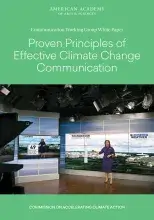Research Paper
Communication Working Group
Proven Principles of Effective Climate Change Communication
Share
Climate change is a complex, interdisciplinary issue, and effectively communicating climate change requires combatting misinformation and reaching across divides to engage people in action.
The Communication Working Group of the Commission on Accelerating Climate Action developed 12 principles for effective climate change communication, ranging from communicating consensus on climate change to framing climate change as an in-group issue. Using examples from across the media landscape, the two publications of this working group highlight needed changes to the ways that climate is discussed broadly.

American Academy of Arts and Sciences
Table of Contents
Communication Working Group Brief
Proven Principles of Effective Climate Change Communication
Communication Working Group White Paper
12 Climate Change Communication Principles
Principle 1: Prioritize a Climate Frame in News
Example 1: Using a climate frame to communicate about a heatwave
Example 2: Commitment by New England Journal of Medicine Group
Principle 2: Communicate Consensus
Example 1: Graphically communicating climate consensus
Example 2: Communicating consensus through a pictograph
Example 3: Dramatizing climate consensus
Example 4: Communicating consensus through analogy
Principle 3: Change Social Norms
Example 1: Opower’s use of social norms to incentivize reductions in energy use
Principle 4: Overcome the Spiral of Silence (If You Believe It, Say It)
Example 1: Actively engaging reporters and the media
Principle 5: Emphasize Nonscientific Identities
Example 1: Emphasizing a familial identity—Science Moms
Principle 6: Frame Climate Change as an In-Group Issue
Example 1: Emphasizing a shared cultural/political identity—New Climate Voices
Principle 7: Make Messages Locally Relevant
Example 1: Using a credible source to highlight local impact
Example 2: Providing tools to help meteorologists localize
Example 3: Providing broadcast meteorologists with educational resources
Principle 8: After Priming an Accuracy Motivation, Encourage Audiences to Draw Their Own Conclusions
Example 1: Engaging audiences through role-playing and simulation
Principle 9: Combine Hope with Actions
Example 1: Deploying a problem-solution narrative structure—Good Morning America
Principle 10: Help People Take Action Themselves
Example 1: Identifying individual action
Example 2: Identifying adaptive action—The risk-response frame
Principle 11: Demand Accountability
Example 1: Reaching audiences in an unanticipated venue
Principle 12: Encourage Commitments in the Form of Accountable Climate Action Plans
Example 1 (corporate): Greenhouse Gas Protocol
Example 2 (municipal): Global Covenant of Mayors for Climate and Energy
Example 3 (non-profit): American College and University Presidents’ Climate Commitment
Example 4 (health care): Health Care Sector Climate Pledge
Example 5 (accountability): Global Fossil Fuel Divestment Commitments Database
Example 6: Tying personal to institutional accountability